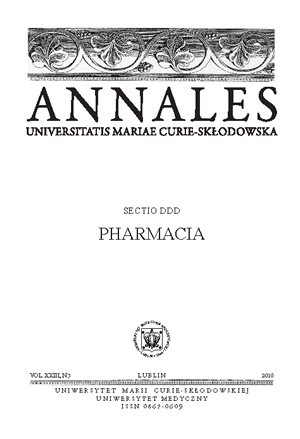Alzheimer’s disease: causes, symptoms and pharmacotherapy
Keywords:
Alzheimer’s disease, acetylcholine, cholinesterase inhibitors, memory and learningAbstract
AD is the most common form of dementia characterized by noticeable decline in cognitive functions. There are several theories explaining the neuronal degeneration in AD including the β-amyloid aggregation, protein τ hyperphosphorylation, oxidative stress and inflammation. In connection with foregoing hypothesis of AD there are several drug targets and strategies of treatment the disease. The most popular and already registered group of drugs is AChEI inhibiting the activity of enzyme cholinesterase and increasing level of acetylcholine in brain what have positive effects on the symptoms of AD. There are also some approaches in AD to inhibiting or modulating secretases activity and reduce the generation of β-amyloid by human cells or produce less of the β-amyloid42 and more of the shorter nontoxic peptides. Very promising line for treating AD is immunotherapy including vaccination and immunization based on usage of β-amyloid, β-amyloid fragments or prepared anti-β-amyloid antibodies. In connection with the inflammatory hypothesis of AD new drugs reducing inflammation are searched. It has been observed that long-lasting therapy with NSAIDs noticeably reduces the risk of AD. It is possible that except inhibiting COX activity there is another mechanism explaining their effectiveness in AD. The adjunctive drugs in AD treatment are natural antioxidants protecting neurons, preventing and eliminating oxidative stress such as flavonoids, polyphenols, vitamin C and E or caffeine and substances such as nicotine (agonist of nicotinic cholinergic receptors). Some positive effects in AD have been also noticed after trials of using in AD drugs such as statins, agonists of M1 muscarinic receptors and antagonists of NMDA receptors.
These and other trials and efforts may effect a successful disease modifying or progression-inhibiting AD treatment in future.
References
1. Arzi A. et al.: Effect of Vitamins C and E on cognitive function in mouse. Pharmacol. Res., 49, 249, 2004.
2. Burn s A. et al.: Alzheimer’s disease. Lancet., 360, 163, 2002.
3. Castellani R.J. et al: Neuropathology of Alzheimer’s disease: pathognomic but not pathogenic. Acta Neuropathol., 111, 503, 2006.
4. Cąkała M., Strosznajder J.: The role of cyclooxygenases in neurotoxicity of amyloid β peptides in Alzheimer’s disease. Neurol. Neurochir. Pol., 44, 65, 2010.
5. Giacobini E.: Cholinesterase inhibitors stabilize Alzheimer disease. Neurochem. Res., 25, 1185, 2000.
6. Harrison F.E. et al.: Ascorbic acid attenuates scopolamine-induced spatial learning deficits in the water maze. Behav. Brain. Res., 205, 550, 2009.
7. Knopman D.: Pharmacotherapy for Alzheimer’s Disease. Curr. Neurol. Neurosci. Rep., 1, 428, 2001.
8. Kruk M., Biała G.: Open mazes - specific animal models of memory and learning. (Otwarte labirynty - specyficzne modele pamięci i uczenia się u zwierząt.). Ann. UMCS Sect. DDD, 19, 95, 2006.
9. Maia L., De Mendonca A.: Does caffeine intake protect from Alzheimer’s disease. Eur. J. Neurol. 9, 377, 2002.
10. Muir J.L.: Acetylcholine, aging, and Alzheimer’s disease. Pharmacol. Biochem. Behav., 56, 687, 1997.
11. Rezvani A.H., Levin E.D.: Cognitive Effects of Nicotine. Biol. Psychiatry., 49, 258, 2001.
12. Salloway S. et al.: Disease-modifying therapies in Alzheimer’s disease. Alzheimers Dement., 4, 65, 2008.
13. Turner P.R. et al.: Roles of amyloid precursor protein and its fragments in regulating neural activity, plasticity and memory. Prog. Neurobiol. 70, 1, 2003.
14. Zhao B.: Natural antioxidants protect neurons in Alzheimer’s disease and Parkinson’s disease. Neurochem. Res. 34, 630, 2009.
Downloads
Published
Issue
Section
License
Copyright (c) 2010 Authors

This work is licensed under a Creative Commons Attribution-NonCommercial-NoDerivatives 3.0 Unported License.


